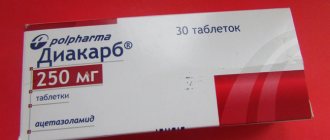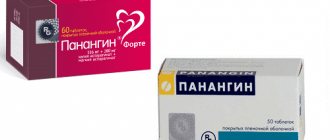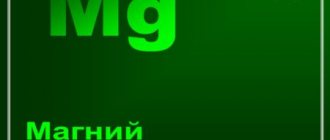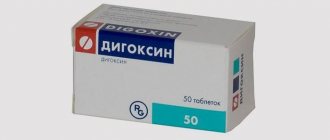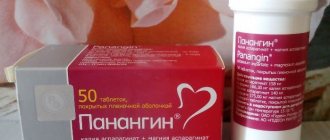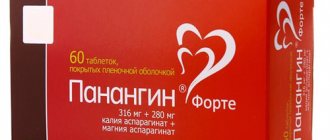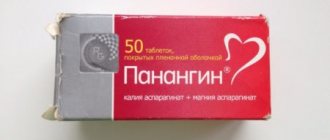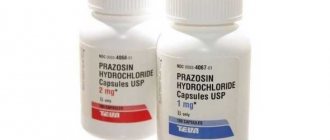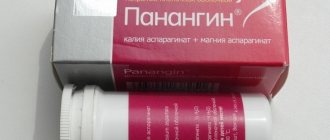Similarity of drugs
Both drugs belong to the same pharmacological group - potassium and magnesium preparations. They also have a common active ingredient - potassium aspartate and magnesium aspartate.
Other common features include:
- The direction of action is to eliminate arrhythmia, replenish deficient microelements in the body.
- Indications and contraindications.
- Side effects in case of dosage violation or due to individual intolerance to the active substance.
- Interaction with other drugs.
- Over-the-counter release.
- Same dosage (with some exceptions).
It is better (for the heart, as well as for the health of the whole body) not to take Panangin or Asparkam for longer than the course prescribed by the doctor, since in this case there is a high risk of developing side effects. The presence of many similarities between drugs is not surprising, since they are interchangeable medical analogues.
Simultaneous use
Is it possible to take Panangin and Asparkam together - of course, but only if their dosages are halved. For example, a patient is recommended to take 6 Asparkam tablets per day. The therapeutic effect will not decrease when using 3 tablets and 3 Panangin tablets. But there is no point in such a combination - the drugs have an identical therapeutic effect.
Panangin and Asparkam taken simultaneously can cause an overdose
But such a situation is also possible - the cardiologist prescribed Panangin to the patient, and the gastroenterologist prescribed Asparkam while taking laxatives. It is strictly forbidden to use them at the same time due to the rapid development of an overdose, which will manifest itself as the following symptoms:
- metallic taste in the mouth;
- paresthesia of the limbs;
- muscle paralysis;
- disorientation;
- respiratory depression.
Urgent intravenous administration of calcium chloride solution is necessary; in severe cases, hemodialysis is required. The simultaneous use of analogues of Asparkam or Panangin, for example, Biolectra Magnesium Fortissimum, Potassium and Magnesium Asparaginate, will also lead to an overdose.
On thematic websites and forums there are opinions of people comparing the results of treatment with Asparkam and Panangin. As a rule, both drugs coped with their task - replenishing magnesium and potassium reserves. They almost do not differ in the lists of possible side effects, indications and contraindications. But their prices vary significantly. For an imported drug you will have to pay about 150 rubles, and a domestic one costs 50 rubles. Some patients noted that Panangin is easier to tolerate by the body. It's all about the presence of an enteric shell, from which the ingredients are gradually released. So if you have chronic pathologies, you should give preference to Panangin.
Differences between medications
The original potassium-magnesium drug is Panangin; it is produced only in Hungary (Gedeon Richter concern). Consequently, the quality control of this medicine is higher than that of its Asparkam counterparts, which also makes its cost more expensive. Asparkam, in turn, is a generic (analogue) that is also produced in Russia.
Important differences include the following points:
- The range of applications of Panangin is wider in comparison with Asparkam.
- Asparkam has slightly fewer contraindications (for example, the instructions for use do not include Addison's disease and hemolysis as undesirable factors).
- Asparkam, when consumed in moderation, can cause hyperglycemia.
- Panangin can be used in pediatric therapy. Aspark is prohibited for use by children under 14 years of age.
This should also include various packaging of the drug in tablet form - Panangin tablets are covered with a protective coating (so as not to damage the walls of the stomach) and they are produced in a polypropylene bottle.
Asparkam is produced in standard cardboard packs with several blisters inside (from 2 to 6). Some doctors also advise patients with diabetes to take the original drug, as its analogues can increase blood glucose levels.
Comparative characteristics
It is difficult to say unequivocally what is better for the heart: Asparkam or Panangin, and what is the difference. There are differences between the drugs, primarily regarding the place of production. Panangin was developed by the Hungarian company Richter. It was she who created the unique composition of the product in the mid-twentieth century. Therefore, this particular medicine is considered original.
Numerous studies have been conducted during which it was possible to prove the effectiveness of taking Panangin for myocardial dystrophy and mitral valve prolapse. The protective shell reduces the impact of hydrochloric acid. The impressive list of contraindications and side effects in the instructions for the drug can frighten the patient. But such information indicates detailed research. Pharmacists have discovered all the possible consequences of taking the medicine.
Panangin is sold in bottles, each containing 50 tablets. The average cost of a package is 150 rubles.
Asparkam is produced by different Russian and Ukrainian companies, which cannot guarantee the quality of the drug. This is an analogue of Panangin and therefore no studies have been conducted. The absence of a protective shell leads to the fact that the active substances are affected by gastric juice - this impairs the effectiveness of the product.
Increasing the amount of magnesium and potassium allows you to reduce the amount of additional components. This reduces the likelihood of developing individual intolerance to the drug. The package contains from 10 to 100 tablets. The patient can choose the appropriate packaging himself. Some manufacturers do not include instructions.
Information on contraindications and side effects is scant. Therefore, you need to use the product carefully. The average cost of 50 tablets is 60 rubles.
A comparison of Asparkam and Panangin reveals slight differences in dosage. In terms of chemical composition and effectiveness, these are the same medicine. When choosing a product, you can focus on price, availability in pharmacies and the individual reaction of the body. There is also no consensus among doctors about what is best to use.
Comparative composition analysis
In addition to the active substance, the drugs contain various additional components (depending on the form of the drug).
Panangin includes the following elements:
- Colloidal silicon dioxide (2 – 4 mg).
- Magnesium stearate (3 – 4 mg).
- Potato starch (3.5 mg).
- Corn starch (87.2 mg).
- Talc (9 – 11 mg).
- The shell contains polyvinylpyrrolidone (3.5 mg).
- Methacrylic acid copolymer E (5 – 7 mg).
- Titanium dioxide (5.5 mg).
Asparkam has a similar composition with the exception of the last three points, which are part of the special capsule shell. The medicine in liquid form also includes calcium stearate, magnesium oxide and potassium hydroxide. In general, the composition of both drugs is identical (the same applies to the concentration of auxiliary components).
Comparison by composition
It should be noted that 2 products, Asparkam and Panangin, have a similar composition. The presence of active components is similar.
For your information! There is no significant difference between the products, and the difference between Asparkam and Panangin concerns only the inclusion of additional ingredients.
Comparison of solution shapes
| Ingredients | solution, mg/ml | Note | |
Asparkam | Panangin | ||
| Magnesium aspartate | 40,00 | The difference in composition concerns only additional components | |
| Potassium aspartate | 45,20 | ||
| Potassium ions in recalculation | 10,33 | ||
| Magnesium ions in recalculation | 3,37 | ||
Comparison of tablets
The tablet form contains a similar composition for both products. A nuance regarding Panangin is the presence of a special coating on the tablets. This coating is necessary to protect the gastric mucosa from the effects of the drug components. When choosing a medicine for people with gastrointestinal pathologies, it is better to choose Panangin than its analogue Asparkam. This preference is due to the fact that Asparkam does not have such a shell.
| Ingredients | tablets, mg | |
Asparkam | Panangin | |
| Magnesium aspartate | 175 | 140 |
| Potassium aspartate | 175 | 158 |
| Potassium ions | 36,2 | |
| Magnesium ions | 11,8 | |
| Additional substances |
|
|
Analogs
During therapy, you can replace Panangin with Asparkam, as well as other drugs:
- Pamaton;
- Aspangin.
Comparison of drugs
| Analyzed parameter | Medicine | |
Asparkam | Panangin | |
| Country of manufacture of the drug | Russia Ukraine | Hungary |
| Price of solution, rub. | From 80 for 10 ampoules | From 150 for 5 ampoules |
| Price of tablets, rub. | From 45 for 50 pcs. | From 150 for 50 pcs. |
| The tablets have a special protective shell | No | Yes |
| The main ingredients contain both magnesium and potassium | Yes | Yes |
| Treatment of pediatric patients | Yes | No |
| Use during pregnancy | If the appointment is justified | Yes |
| Excretion from the body | Kidneys | |
| Dispensing tablets without a prescription | Yes | Yes |
| Appearance on the market of drugs | Later | Earlier |
| Original/generic | Generic | Original |
Mechanism of action
It is better to use Panangin or Asparkam (for the heart and circulatory system as a whole) as specially prescribed mineral supplements to the main therapy. Both drugs regulate metabolic processes in the body.
The active substance – aspartate – delivers potassium and magnesium ions inside the cells and tissues of the body, as a result of which the following reactions occur:
- Electrolyte balance is normalized and restored.
- Potassium ions prevent the occurrence of arrhythmia, maintaining normal heart muscle activity.
- There is a decrease in the excitability and conductivity of the cardiac muscle tissue.
- Magnesium promotes better penetration and absorption of potassium in cells.
Magnesium ions increase coronary blood flow and have an anti-ischemic effect by reducing heart rate and reducing the need for oxygen in the heart muscle.
The combination of magnesium and potassium ions leads to a decrease in the toxicity of cardiac glycosides. In addition, potassium minerals entering the body help maintain homeostasis and prevent the formation of blood clots.
Indications
Due to their composition, both drugs are the most popular in the pharmaceutical market. The main difference between Panangin and Asparkam is reviews and prices.
Medicines prescribed:
- With a deficiency of potassium and magnesium salts.
- Atrial fibrillation of the heart.
- A multi-purpose treatment method for people who have survived a heart attack.
- As an additional source of salts when taking digitalis preparations.
- A source of essential microelements in case of poor or dietary nutrition.
- Source of potassium when taking diuretics.
Indications for use
Panangin or Asparkam is better for the heart in case of chronic failure when combined with drugs based on digitalis. However, any therapy must be agreed with the attending physician. These medications are most often prescribed to correct potassium or magnesium deficiency in the body.
Other indications include:
- Therapy for coronary heart disease, as well as acute myocardial infarction and in the post-infarction period.
- Various types of arrhythmia (including cardiac arrhythmias as a result of an overdose of cardiac glycosides).
- Chronic heart failure.
- Hypokalemia.
Drugs can also be prescribed for hypomagnesemia, when using glucocorticosteroids, as well as during therapy with diuretics and saluretics.
User reviews
Before purchasing any product, it is better to read reviews. They contain useful information that will help you make your choice. For example, sometimes you may find information about unexpected side effects.
After a heart attack, the doctor recommended taking Panangin, but I was faced with the fact that not all pharmacies can buy it. The pharmacist recommended replacing it with Asparkam. It costs less, is always on sale and is not inferior in effectiveness to the original drug. I didn't notice any side effects.
Due to heart failure, I take Panangin in courses. After treatment, significant improvements occur. But I don’t always have enough money, so sometimes I buy Asparkam. The domestic analogue is no worse, but it can make your stomach hurt. In general, the alternative remedy is effective and helps cope with the lack of potassium and magnesium in the body.
My doctor prescribed Asparkam for the treatment of seizures. I felt the effect of taking it only after several weeks. The tachycardia and arrhythmia disappeared, but I didn’t notice any special sedative effect. The only drawback of the drug is a feeling of heaviness in the stomach. That's why I switched to Panangin.
Angina attacks, the appearance of heart pain, and arrhythmias can eventually lead to myocardial infarction. In order to avoid such a development of events, it is necessary to think about possible preventive measures that can, if not cure, but stop such a scenario.
The main cause of heart attacks is insufficient oxygen supply to the myocardium caused by spasm of tissues and blood vessels. This leads to necrosis of the heart muscle. But with proper treatment, it is possible to stop tissue death.
As a rule, complex therapy for cardiovascular diseases includes nitrates (to relieve attacks of ischemia), vasodilators, and vitamin preparations. Not the last place in this list is occupied by preparations of potassium and magnesium salts, “Asparkam” or “Panangin”. What's better? And what's the difference?
Main contraindications
A common contraindication for both drugs is individual intolerance to potassium and magnesium drugs. Long-term use of the drug can only be carried out under the supervision of doctors with regular monitoring of electrocardiography data.
Taking medications based on potassium and magnesium aspartate is prohibited for the following pathologies:
- Presence of hyperkalemia or hypermagnesemia.
- Antiventricular block (from 1st to 3rd degree).
- Acute renal failure.
- A history of severe autoimmune disease (for example, myasthenia gravis).
- Cardiogenic shock.
- Dehydration.
- Metabolic and endocrine diseases (acidosis, ketoacidosis, complications of diabetes mellitus).
- Oxidative deamination disorders (aminoaciduria).
- Gastroduodenal ulcers.
- Oliguria.
Drugs should be taken with caution in case of hypophosphatemia, urolithiasis and chronic renal dysfunction. Also, patients who have hereditary fructose intolerance should consult a doctor before taking magnesium supplements.
Contraindications
What else is the difference between Asparkam and Panangin - the number of contraindications. They should not be used in case of hypersensitivity to the components. Since Panangin has more ingredients, it is not advisable to replace Asparkam with it without consulting your doctor. If a person has an individual intolerance to one of the components of the pills that are not in the tablets, then it will certainly manifest itself in a powerful systemic or local allergic reaction.
Doctors do not prescribe Panangin to patients with the following pathologies:
Analogue of Asparkam
- disorders of amino acid metabolism;
- liver or kidney pathology that has become chronic;
- hemolysis;
- exicosis;
- dehydration;
- arterial hypotension;
- muscle weakness;
- atrioventricular block;
- hypermagnesemia;
- hyperkalemia;
- metabolic acidosis;
- Addison's disease.
Treatment of patients with Panangin is carried out under the supervision of a doctor if they have urinary disorders, especially urinary retention. Constant blood monitoring is required to promptly detect excess accumulation of potassium and magnesium in the body. Here Asparkam is practically no different from Panangin. All of the above contraindications for dragees are also typical for tablets. Both can be used in the treatment of newborns. But when calculating single and daily dosages, doctors take into account the weight and age of the child.
Panangin and its analogue Asparkam are not advisable to use during pregnancy and breastfeeding.
Manufacturers have not provided data on the safety of treatment with Asparkam or Panangin during pregnancy and lactation. Therefore, it is undesirable for these categories of patients to use it. Drugs are prescribed only by a doctor after assessing their benefits for the woman and the risk to the child, as well as if safer antiarrhythmic drugs are ineffective.
Vacation conditions
Potassium-magnesium medicines are available without a prescription. The drug does not have any effect on the reaction rate, so there are no restrictions on driving or operating machinery after taking the drug. Also, Panangin and Asparkam practically do not cause drowsiness and, if the dosage is observed, the likelihood of side effects is relatively low.
For pregnant women
There is currently no evidence of negative effects on the fetus during pregnancy due to the lack of research. There is also no data on the penetration of the active substance and components of the drug into breast milk. However, it is recommended not to include these drugs in general therapy during pregnancy.
For children and teenagers
Panangin or Asparkam is better for the heart and immune system not to be taken by children and adolescents under 14 years of age. Panangin can be used for pediatric therapy only as an adjuvant - as a food supplement in case of a lack of magnesium or potassium in the body.
At the moment, there is no information about the effect of Asparkam on the children's body, so its use can be justified only in cases where the expected benefit is higher than the possible harm.
What to drink with?
Do not forget that even taking vitamins can affect the pharmacological properties of medications. Therefore, you should be careful about what you take and with what.
Research has been conducted and experts have voiced reviews about “Pananigin” or “Asparkam” - which is better not to take with them. Those at risk for possible future hyperkalemia are people taking drugs to treat hypertension with potassium retention effects.
New generation diuretics also tend to retain potassium in tissues. If they are consumed together with potassium, an increase in the content of this element in the blood is inevitable. The exception is non-steroidal anti-inflammatory drugs, heparin, antibiotics (Polimexin, Neomycin).
In addition, there is a possibility of poor absorption of potassium and magnesium salts in the stomach while taking tetracycline, iron supplements and sodium fluoride. Their use is possible only if one of the dosage forms is taken no earlier than three hours later.
The difference in the warnings for Asparkam and Panangin is the incompatibility with drugs for anesthesia (the nervous system is depressed) and muscle relaxants (muscle blockade increases). Such a warning exists only for Asparkam.
Side effects
The most common side effects from taking the drug include nausea, vomiting, dizziness and headache. The magnitude and intensity of side effects depends, first of all, on the patient’s medical history and general condition.
In certain cases, the following negative effects may occur after taking medications (both Panangin and Asparkam):
- Decreased blood pressure, tinnitus.
- The occurrence of arrhythmia, bradycardia.
- Diarrhea.
- General weakness of the body - fatigue, lethargy, pain in the muscles.
- Cramps.
- Redness of the face, feeling of heat in the body, a sharp increase in temperature.
- The appearance of ulcers on the mucous membrane of the gastrointestinal tract.
- Allergic reactions - skin rashes, scabies, itching.
The bulk of side effects were recorded when the drug was administered intravenously too quickly. In some cases, antiventricular block (1st degree), respiratory depression, and phlebitis developed.
Also, when using the injection form of the drug, there is a minimal risk of swelling throughout the body. If any of the above effects occur, you should immediately consult your doctor to change the medicine or discontinue it.
The difference between Asparkam and Panangin
In order to compensate for the lack of K and Mg in the body, today doctors often prescribe Asparkam or Panangin. The drugs are identical in composition, but there are differences between them.
In order to compensate for the lack of K and Mg in the body, today doctors often prescribe Asparkam or Panangin.
Release forms and storage conditions
Today, drugs have two forms of release - in the form of tablets or capsules, as well as a concentrate for the preparation of solutions for injections and infusions. The tablet form of Panangin is a film-coated capsule placed in a small tube; the number of capsules in one tube is 50 pieces.
The greenish solution for infusion is placed in a small glass ampoule with a volume of 10 ml. There are from 5 to 10 pieces in a package.
Asparkam is available in a cardboard box containing blisters of 10 tablets; the number of blisters varies from 3 to 5. The injection solution is available in the form of glass ampoules of 5, 10 and 20 ml. The number of ampoules is from 5 to 10 pieces in one package.
Both drugs must be stored in a dark place at a temperature of 14 to 26 degrees Celsius, protected from exposure to ultraviolet rays. The shelf life of both drugs is 3 years.
Justification of choice
Both drugs have identical composition. They were not specifically tested, but according to doctors, it is better to take Panangin. Despite the identity of the composition, the Hungarian manufacturer inspires more confidence in the quality of the products produced.
For those who crush tablets before taking, it is more convenient to drink Asparkam, which is available in the form of uncoated tablets. For those patients who swallow tablets whole, it is better to give preference to the pill form produced by a Hungarian pharmaceutical company.
The difference between Panangin and Asparkam is insignificant, relating mainly to the country of origin and price . Therefore, if the question arises about choosing a drug, replacing one drug with another will not affect the quality of treatment.
Optimal dosage
Drugs in tablet form should be taken only after meals, as gastric juice can reduce the effectiveness of the active substance. The tablets must be taken with warm water.
The dosage, depending on the patient’s condition and age, may look like this:
- For an adult (18 – 50 years old) – 1-2 tablets 3 times a day (no more than 6 tablets per day).
- For older people – 1 tablet 3 times a day.
- For patients with heart failure and other heart pathologies – 1-3 tablets 3 times a day (as prescribed by a doctor).
- To replenish missing minerals in the body - 1 tablet 3 times a day.
The average course duration is from 3 weeks to a month. If necessary, therapy can be resumed or extended. Intravenous injections and infusions are prescribed in emergency cases, as well as in combination cardiac therapy.
To prepare the liquid form of the medicine, use ampoules (1-2 pieces), which are diluted in a glucose solution; if necessary, the solution is reintroduced 4-6 hours after the last procedure.
What common?
Both of these drugs, so to speak, are built on potassium and magnesium - this is the basis of heart medications. Both of these drugs can be administered to the body orally (tablet form, which we wash down with water) and through injections (injections).
Asparkam, based on reviews on the Internet and reviews of my fellow athletes, is quite a good way to heal your heart or support it, to help with work during heavy physical activity. As for Panangin, there are no fewer positive reviews on the Internet than asparkam, but in the community of athletes this drug is used much less frequently. Much.
Athletes are guided by the following principle: why pay “three dears” if a simple remedy is enough. Not every athlete has heart disease that needs to be treated (which Panangin can handle better), but everyone wants to help their heart (which, in principle, Asparkum can handle quite well). You see, I am already hinting at some differences in the ethics of medicines.
Drug interactions
Panangin, like Asparkam, can enhance the negative effects of taking antiarrhythmic drugs for the heart. In particular, magnesium and potassium aspartate affects the bathmotropic and dromotropic effects of beta-blockers (Pindolol, Propranolol).
For clarity, other features of the interaction of these drugs with other drugs are best presented in table form:
| Group of drugs | Interaction effect | Side effects |
| Diuretics, glucocorticosteroids | Hypokalemia that occurs when taking them is eliminated | Drugs can be combined |
| Anesthetics | Increased inhibitory effect on the central nervous system | Development of side effects from the central nervous system |
| Suxamethonium, Decamethonium, Atracuronium | Concomitant use may result in increased neuromuscular blockade | Risk of developing heart pathologies |
| Adsorbents with enveloping and astringent action | The effectiveness of adsorbents is reduced due to worse absorption into the gastrointestinal tract | Reduced efficiency of adsorbing properties and, as a result, the risk of poisoning |
| ACE inhibitors, Heparin, Cyclosporine | Increased risk of developing hyperkalemia | Heart rhythm disturbances, arrhythmia |
| Insulin, Dextrose | The work of the heart muscle is normalized | Drugs can be combined |
During potassium-magnesium therapy, the use of non-steroidal anti-inflammatory drugs is not recommended to avoid the risk of side effects. The preparations Panangin and Asparkam are well compatible with solutions of cardiac glycosides (which are part of not only digitalis, but also lily of the valley, icterus, and spring adonis).
The high magnesium content in the preparations makes the simultaneous use of Panangin and Asparkam with tetracycline, streptomycin and polymyxin B inappropriate.
Features of the composition
If you compare Panangin and Asparkam, you will find some differences in the composition of antiarrhythmic drugs. First of all, the products differ in the quantitative content of active ingredients that determine their therapeutic effectiveness. It is determined by the pharmacological properties of magnesium and potassium aspartates. Domestic Asparkam contains exactly 0.175 g each. But Panangin from the Hungarian manufacturer contains 0.14 magnesium aspartate and 0.158 g of potassium aspartate.
Such differences in the compositions of Panangin and Asparkam suggest that the therapeutic effect of the latter is slightly stronger. In fact, such a slight difference in the quantitative composition of drugs is practically unnoticeable to the human body. They also differ in the substances that manufacturers use to form the base of the tablets.
The auxiliary composition of Panangin is represented by the following components:
- silicon dioxide;
- corn and potato starch;
- talc;
- povidone;
- magnesium stearate;
- macrogol;
- methacrylic acid copolymer.
Additional ingredients ensure optimal distribution of the active components, prolonging their effect, as well as somewhat enhancing it. And the durable shell protects aspartates from aggressive enzymes and hydrochloric acid produced by the parietal cells of the stomach. To form the basis of Asparkam tablets, the manufacturer used the following substances:
- corn starch;
- talc;
- calcium stearate;
- polysorbate.
Additional ingredients not only act as stabilizers and preservatives. They promote more complete absorption of aspartates into the systemic circulation. Auxiliary components are responsible for their uniform distribution in target organs and their rapid manifestation of therapeutic activity.
It is quite possible to judge whether Asparkam or Panangin is better based on the additional composition of the ingredients. The presence of a protective shell in the latter somewhat reduces the likelihood of a negative effect of the drug on the stomach. But at the same time, the large number of auxiliary components of Panangin precludes its use by people with hypersensitivity to them.
Caution when taking potassium-magnesium drugs
Hypokalemia and hypomagnesemia negatively affect almost all body systems. However, excess magnesium and potassium are also dangerous to health.
The following precautions should be observed when taking these medications:
- Stop drinking alcohol and smoking during therapy.
- It is important to inform your doctor about all medications you have recently used (including dietary supplements and vitamin complexes).
- If you are pregnant or planning to become pregnant, you should also consult your doctor about the selection of medications.
- You should not use potassium-magnesium drugs before an operation that involves placing the patient under anesthesia.
It is also not recommended to use Panangin and Asparkam during the acute stages of certain diseases (for example, pancreatitis). The tablets must be taken with water only, since any other drinks - including tea and coffee - contain many substances that can interact with the components of the drugs.
If you miss a dose, you cannot take a double dose the next day (as a kind of “compensation”); it is necessary to return to the calculated dosage as soon as possible.
special instructions
Taking drugs through intravenous administration should occur slowly to avoid possible overdose and side effects. If, when mixing the drug concentrate with a glucose solution, a clearly visible cloudy precipitate is observed, then such a solution cannot be used for medical purposes.
Overdose
In clinical trials of drugs, overdose was observed extremely rarely. Excess potassium and magnesium aspartate can negatively affect the functioning of the body.
Typical symptoms include:
- Nausea, vomiting.
- Increased fatigue.
- Confusion.
- Risk of hyperkalemia and hypermagnesemia.
As a result of excess potassium and magnesium, heart pathologies (bradycardia, arrhythmia) may worsen; An increased level of magnesium ions in the blood can lead to inhibition of deep tendon reflexes. The antidote is calcium chloride, which must be administered intravenously (approximate dosage is 100 mg/min). In some cases, hemodialysis and peritoneal dialysis are also necessary.
What are the drugs for?
The difference between Asparkam and Panangin lies in the indications for use in clinical practice. They are intended for complex therapy of pathologies complicated by magnesium and potassium deficiency. Their deficiency in the body always manifests itself as heartbeat disorders and negatively affects blood pressure. Therefore, various arrhythmias are indications for the use of these drugs. Panangin is included in the therapeutic regimens of patients suffering from the following pathological conditions:
- hypomagnesemia;
- hypokalemia;
- myocardial infarction;
- heart failure;
- complications arising from the accumulation of digitalis in the body;
- ventricular extrasystole;
- atrial extrasystole;
- supraventricular tachycardia;
- paroxysmal tachycardia.
Both Asparkam and Panangin are usually used when taking medications with a pronounced diuretic or laxative effect. Their use, especially in high doses, leads to a large loss of body fluid. Along with water, it leaves micro- and macroelements necessary for the proper functioning of all life systems. The cardiovascular and central nervous systems are especially affected by the resulting deficiency of potassium and magnesium. Taking Panangin or Asparkam helps replenish their reserves.
The latter is also prescribed to patients after diagnosing the following diseases:
- heart failure;
- post-infarction conditions;
- arrhythmias provoked by disorders of water and electrolyte balance;
- hypomagnesemia;
- hypokalemia.
Thus, the difference between Panangin lies in the wider list of its indications for use. But in practice, they and Asparkam are quite interchangeable. For example, the latter is often used in combination with cardiac glycosides to neutralize their toxic effects. Despite the fact that such an indication is not on the Panangin list, it can also be used for this purpose.
Helpful information! According to clinical studies, taking Asparkam helps to avoid severe complications of cerebrovascular disease. Subarachnoid and cerebral hemorrhages and cerebral infarctions occur much less frequently.
Choice of drugs
Based on reviews from people who have used both Asparkam and Panangin, there is not much difference between these drugs if they are used as an additional source of potassium and magnesium.
It is necessary to focus on the individual characteristics of your body. If medications are part of therapy for heart disease, then you should follow the advice of your doctor.
Asparkam or Panangin
The original drug Panangin has passed many medical tests, so it can be recommended to those who are concerned about the safety and reliability of medicines. Domestic analogues are cheaper, however, in this case the risk of purchasing a fake is higher.
Asparkam may be recommended in cases where the patient prefers not to drink the tablets, but to grind them into a powder - for such cases, Panangin capsules, protected by a special shell, are not suitable. If the patient has diseases of the gums or teeth, then Panangin should be taken.
Panangin or Panangin-Forte
The difference between the drugs is in the dosage of the active substance. Classic Panangin contains 141 mg of magnesium aspartate and 159 mg of potassium aspartate in one tablet. Panangin-Forte concentration is twice as high - 280 mg of magnesium aspartate and 304 mg of potassium aspartate.
The enhanced formula is suitable for those who have a serious deficiency of potassium and magnesium, as well as for chronic diseases of the heart and circulatory system. Standard Panangin tablets are prescribed for the prevention of stroke, arrhythmia, and also as a dietary supplement. In all other aspects (indications, side effects) these drugs are identical.
Pamaton and Aspangin
Aspangin is another domestic analogue of Panangin, the pharmacological action of which exactly corresponds to all magnesium-potassium preparations. There are minor differences in the dosage (175 mg of potassium and magnesium), as well as in the number of tablets in the packages - a cardboard pack of Aspangin can contain from 20 to 60 tablets placed in plastic blisters.
Pamaton, in turn, is an analogue of Aspangin with the same dosage (175 mg of potassium and magnesium). The drug has several additional contraindications - stomach ulcers and pancreatic diseases. It should also be used with caution for burns and myasthenia gravis; in this case, the patient should be under medical supervision.
Features of application
Since Asparkam differs slightly from Panangin, the features of treatment with these drugs are the same:
- medications do not affect the ability to drive a car or reaction speed;
- active substances may affect the effect of other medications taken, so this point must be taken into account when prescribing;
- intravenous administration may be accompanied by redness of the skin;
- if there is a risk of increasing potassium levels in the blood, the medication should be prescribed with caution and under the supervision of tests.
Use during pregnancy
No special studies have been conducted on the effects of Asparkam on the body of a pregnant woman. If therapy is necessary during this period, both the benefits to the mother and the risks to the fetus must be taken into account. Unlike Asparkam, Panangin is approved for use during pregnancy.
For your information! Neither Panangin nor Asparkam is prescribed to pregnant women prophylactically, as it gives a high concentration of ions.
Application in the treatment of children
Clinical studies of Panangin in this direction have not been conducted. Therefore, it is not prescribed for the treatment of children. Asparkam for children is indicated only for potassium deficiency, which is confirmed by laboratory data. Such a condition, which makes it necessary to take Asparkam, may be associated with frequent vomiting, prolonged diarrhea, serious pathologies of the kidneys and liver, etc.
Use by athletes
Asparkam, as a time-tested source of potassium and magnesium, in combination with Riboxin, is prescribed to athletes to strengthen endurance for strength and cardio exercise. At the same time, the efficiency of the heart itself increases and its blood supply improves.
During sports training and physical activity, Asparkam (Panangin's choice is similar) allows the heart to contract less. The heart rate remains within acceptable limits, even under significant loads. In addition, taking potassium and magnesium supplements compensates for the loss of these elements during training.
To reduce body weight
When following most diets, there is always some limitation in the choice of food and menu design. The difference between Asparkam and its analogue Panangin in this matter is not significant. They both are often used to achieve better results in the fight against excess weight.
The microelements included in the preparations partially compensate for dietary limitations and accelerate metabolic processes. At the same time, fat cells are broken down more efficiently and toxins are eliminated more energetically, especially when combined with physical exercise.
Is it possible to overdose
Taking any of the medications under consideration can cause side effects from the gastrointestinal tract and cause disruptions in the functioning of other systems.
For your information! If adverse reactions occur, patients are prescribed symptomatic therapy.
Taking it by injection can give the following manifestations in large dosages:
- disruption of normal breathing;
- convulsions;
- facial hyperemia;
- nausea;
- drowsiness;
- nausea;
- itching, etc.
The combined use of potassium-containing drugs (Asparkam and similar drugs) with non-steroidal anti-inflammatory drugs and antibiotics can affect the heart rhythm.
If potassium supplements are taken simultaneously with glucocorticosteroids, then the electrolyte balance is normalized, which is reduced by taking hormonal drugs. The negative consequences of taking cardiac glycosides can also be compensated.
An overdose of Asparkam and Panangin is possible with injections.
The patient may have the following symptoms:
- heart rate slowdown;
- difficulty breathing;
- nausea, etc.
To normalize the patient’s condition in the hospital:
- calcium chloride is administered intravenously;
- hemodialysis is prescribed.
Price comparison
The cost of medications depends on their form of release, as well as on the pharmacy. The most expensive drug is Panangin-Forte - its price ranges from 180 to 400 rubles. per package. The drug with vitamin B6 costs about 250 rubles. Classic Panangin costs from 100 to 200 rubles. in tablet form and from 120 to 250 rubles. in the form of a solution for infusion.
For other potassium-magnesium drugs, the price is as follows:
- Asparkam Avexima - from 60 to 90 rubles. per package (60 tablets).
- Asparkam L – 30-40 rub. per package (20 tablets).
- Asparkam in the form of a concentrate for injection – 50-70 rubles. (5 ampoules).
- Aspangin – 80 rub. (30 tablets).
- Pamaton – 70 rub. (50 tablets).
Medicines (Panangin, Asparkam or their analogues) are used only as an adjunct to the main therapy.
Mineral supplements and vitamin complexes should not be chosen independently, without consulting a specialist, since an excess of certain substances can be just as harmful as their deficiency. Therefore, for the heart and other vital organs, it is better to strictly follow the course of treatment prescribed by the doctor.
Article design: Vladimir the Great
Pregnant, nursing mothers, drivers and children
No special medical studies have been conducted on the use of mineral salt preparations in pregnant and lactating women. But there are known cases of pregnant women using Asparkam or Panangin. There have been no reviews of whether it is better or worse tolerated. The main point is that no harm was observed from taking it in nursing women and expectant mothers.
But we must remember that Asparkam is intended to be taken only when the benefit to the mother outweighs the risk to the fetus. But “Panangin” is not prohibited from being used by this category of consumers.
Since medications do not affect the nervous system, general well-being and reaction speed, drivers are allowed to use them.
Due to the lack of clinical studies on the effect of potassium and magnesium aspartate on the body of children, the use of tablets in pediatric practice is strictly prohibited.
What is better to take - Asparkam or Panangin?
In terms of the effectiveness of the dissolving effect on kidney stones, there is no difference between medications. The choice of remedy depends more on the method of administration. If the patient is going to crush the tablets before use and take them with food, it is more convenient to use Asparkam; for swallowing the tablets whole, it is better to choose Panangin.
In addition, Panangin is safer for gastric and duodenal ulcers, entrocolitis and other gastrointestinal diseases. However, after the protective shell dissolves, the medication will still come into contact with the intestinal and gastric walls, so in case of pathologies of the gastrointestinal tract, caution should be exercised when taking these drugs during or after meals.
Action of Panangin
Panangin is considered more effective than its analogue, because it has undergone numerous clinical studies.
Panangin tablets have the following features:
- Covered with a protective film that reduces the negative impact of gastric juice on the drug.
- The content of Mg aspartate is 140 mg, K aspartate is 158 mg.
- There are additional components.
The annotation describes in detail the undesirable consequences. There may be disturbances in the conduction of electrical impulses from the atria to the ventricles, and the occurrence of premature heart contractions. The digestive system may react with internal discomfort, vomiting, and indigestion.
Digestive upset may indicate an overdose of K, which is also characterized by sensory disturbances. Excess Mg is manifested by redness of the skin of the face, decreased blood pressure, thirst, depression of breathing and reflexes, and convulsions.
How to use
Pills
The medicine in tablet form is intended for oral administration. You can take 2 tablets three times a day. For maintenance purposes, you can take 1 tablet three times a day. The treatment course is 20-25 days.
In special cases, an additional therapeutic course may be required.
Intravenous administration
Panangin in the form of a solution should be administered intravenously slowly, drip-wise. The rate of administration of the drug should not be more than 25 drops per minute. This procedure can be carried out no more than 2 times a day. No more than 300 ml can be administered at a time. The dosage of the medicine for pregnant women does not require adjustment and is carried out according to the standard scheme.
For prevention purposes
Patients are often interested in questions regarding the benefits and harms of a drug. It is worth understanding that Panangin can cause many negative reactions, so you should not use it for preventive purposes. This is explained by the fact that taking medications will cause the body to become accustomed to a certain content of microelements or may lead to an excess of these microelements in the human body, which will entail many negative consequences.
